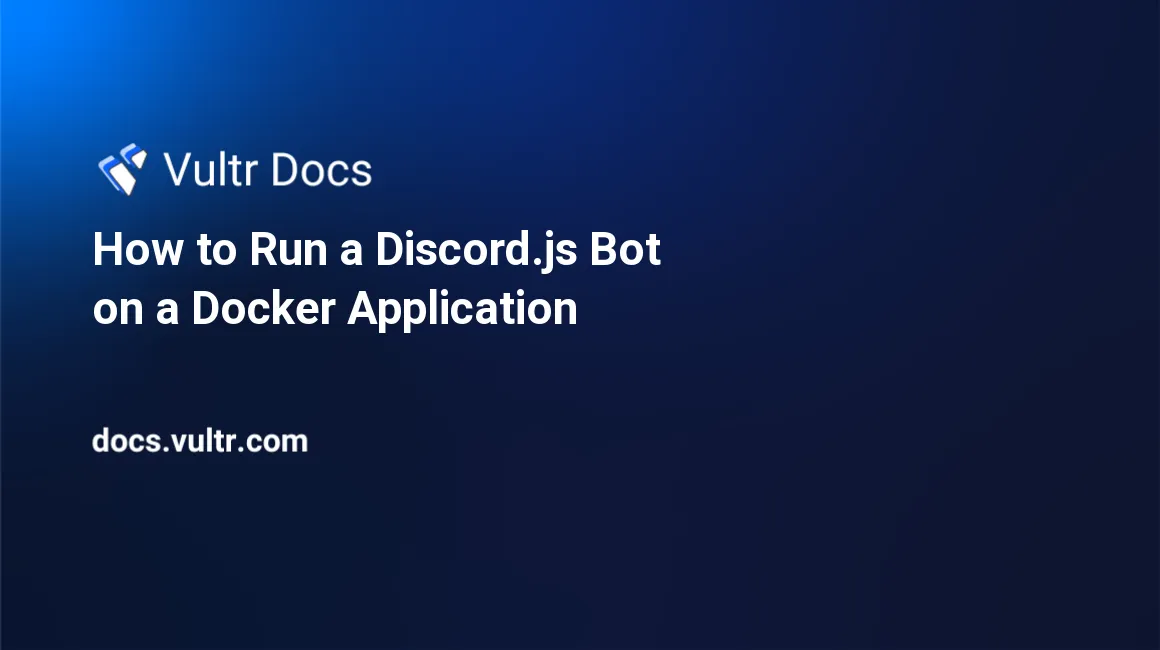
Introduction
Discord is a video, voice, and text communication platform that allows bots to perform automated tasks based on user commands. This article explains how to run a Discord.js bot on a Docker application.
1. Create a Discord Application
- Go to the Discord Developer Portal and log in.
- Click the New Application button.
- Enter an application name and click Create.
- Select the Bot tab from the Settings menu.
- Click Add Bot then click Yes, do it!.
- Click Copy to copy your bot's token to the clipboard. Save a copy to use later in this guide.
2. Install Prerequisites
- Deploy a Docker application on Ubuntu 20.04 cloud server Instance from Vultr Marketplace Apps
- Login as root
3. Install Dependencies
Install Node.js, a javascript runtime that is required for Discord.js.
# apt-get install nodejs -yInstall Node Version Manager (nvm), which is used to update Node.js. For example:
# wget -qO- https://raw.githubusercontent.com/nvm-sh/nvm/v0.38.0/install.sh | bash> Note: Please see NVM's github repository and use the command for the latest NVM version.
Reboot the server.
# rebootReconnect to the SSH session.
Verify the nvm installation:
# command -v nvmIt should return:
nvmUpdate Node.js to the latest version:
# nvm install node
4. Create the Discord Bot
Switch to your home directory.
# cd ~Create a project folder.
# mkdir discord-botSwitch to the project folder.
# cd discord-botInitialize your Node.js project.
# npm initAnswer the questions. Leave the defaults unless you need to change them.
Check the contents of your
package.jsonfile:# cat package.jsonIt should return something like this:
{ "name": "discord-bot", "version": "1.0.0", "description": "A Discord.js bot", "main": "index.js", "scripts": { "test": "echo \"Error: no test specified\" && exit 1" }, "author": "", "license": "ISC" }For this guide, you need to install the Discord.js library using npm. Then, as you add capabilities to your bot, look for other useful libraries on the npm website.
Install the Discord.js library.
# npm install discord.js --saveThe
--saveflag adds the library as a dependency in yourpackage.jsonfile.Create a file named
index.js.# nano index.jsPaste this sample code to your
index.jsfile. Replace<YOUR BOT TOKEN>with the token you saved in section 1.const { Client, Intents } = require('discord.js'); const client = new Client({ intents: [Intents.FLAGS.GUILDS, Intents.FLAGS.GUILD_MESSAGES] }); client.on('message', message => { if (message.content === 'hello') { message.channel.send('Hello World~!'); } if (message.content === 'testbot') { message.channel.send("Hi! I'm up and Running~!"); } if (message.content === 'ping') { message.channel.send('Pong~!'); } }) client.once('ready', () => { console.log('The Discord Bot is Ready!'); }) client.login('<YOUR-BOT-TOKEN>')The Discord bot should respond to
hello,testbot, andpingcommands.Save and exit the
index.jsfile.Create a
Dockerfile.# nano DockerfilePaste this to your
Dockerfile.FROM node:latest # Create the bot's directory RUN mkdir -p /usr/src/bot WORKDIR /usr/src/bot COPY package.json /usr/src/bot RUN npm install COPY . /usr/src/bot # Start the bot. CMD ["node", "index.js"]Save and exit the
Dockerfile.
5. Run the Discord Bot
Change to the Discord bot project directory.
# cd ~/discord-botBuild the docker container for the Discord bot.
# docker build -t discord-bot .Run the docker container.
# docker run -d discord-bot
Running the bot with -d flag runs the container in detached mode (it runs in the background).
Common Docker Commands:
List all docker processes:
# docker psStop the docker container (discord bot):
# docker stop <CONTAINER ID>Restart the docker container:
# docker restart <CONTAINER ID>
You can find the <CONTAINER ID> when you list all the Docker processes.
6. Invite the Bot to a Discord Server
- Go to the Discord Developer Portal and login.
- Click the Application that you have created.
- Navigate to the OAuth2 Tab from the Settings menu.
- In the Scopes Section, select bot.
- In the Bot Permissions Section, select Administrator. This gives the bot an Administrator Role from the Discord Server.
- Click the Copy Button to copy the generated invite link.
- Open the invite link on your browser.
- Select the Discord server to add the bot to then click Continue.
- Authorize the bot and complete the CAPTCHA.
The Discord bot is now up and running.
More Information
To learn more about Discord bots, please see these resources: